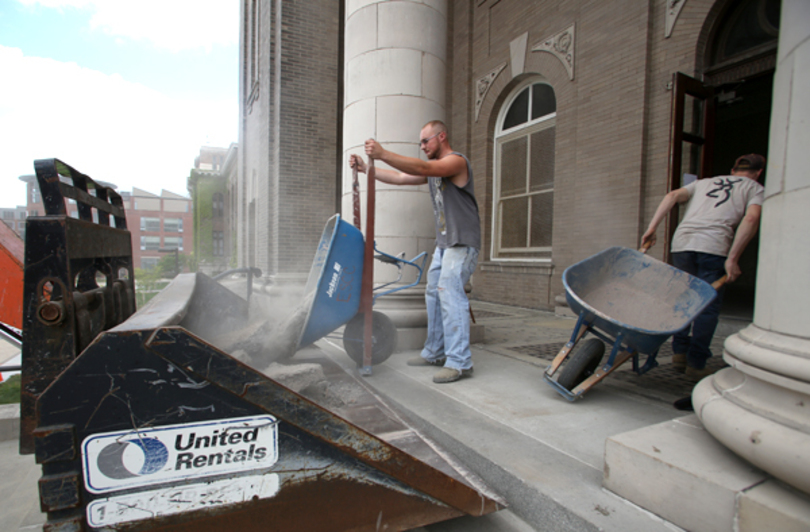Carnegie Library undergoes updates, restoration
Four months into the renovation on Carnegie Library’s grand main entrance and Reading Room, areas on the first and second floor are still in early phases of construction, stripped down and dusty, with wires exposed.
The Reading Room restoration, part of a five-year project to update and restore Carnegie and funded by the university for several million dollars, has not come without difficulties. Obstacles include dealing with a major construction project in a building where almost every Syracuse University student takes a class, responding to the competing needs of the library and mathematics department and general construction setbacks.
To Suzanne Thorin, dean of the libraries and university librarian, these construction setbacks are merely part of the process to restore Carnegie, home to the mathematics department and Science and Technology Library, which currently occupy the building.
Carnegie opened in 1907 after the Andrew Carnegie Foundation made a donation of $150,000 to SU, and served as the main library on campus until 1972.
“There’s no question the project is worth it,” said Thorin, who has wanted to restore the building since coming to SU in 2005.
Through the years, changes to the building included blocking off the original main entrance to make room for classes and uprooting the statue of the goddess Diana from Carnegie’s foyer to the second floor of E.S. Bird Library.
The latest construction will restore the entrance and bring back Diana, as well as clean the yellowed scagliola columns, remove the windows from the third-floor ambulatory, add LED desk lamps, new Stickley furniture, a larger elevator and handicap-accessible bathrooms.
But part of the construction process means moving books from Carnegie into storage to create shelf space. Eugene Poletsky, chair of the mathematics department, fears this, recalling the ease of running to the library to look up a journal article. Mathematics faculty members publish at least 50 papers per year in peer-reviewed journals, Poletsky said.
To Poletsky, the Reading Room restoration represents a “Potempkin Village,” the Russian myth of a village created from hollow facades to impress a traveling monarch.
“This is a very nice facade, but behind this facade there will be a partial library,” Poletsky said.
TC Carrier of the Program Management Center said the mathematics department should have adequate access to materials since what was moved included journals, most of which are available online, and monographs that have not been circulated in five or more years. Carnegie is able to hold approximately 194,000 volumes depending on book size, Carrier said. The library was holding close to 400,000 monographs and journals.
The library is currently open during construction and all call numbers between Q and Z in the Library of Congress classification system are in the collection per the library’s long-range plan.
Poletsky said he is still concerned about and said the mathematics department was not given time to provide input or disagree with the construction project, which was announced at the end of the academic year. Early in the summer, he wrote to the University Senate Committee on the Library, and communicated with Vice Chancellor and Provost Eric Spina, and Lou Marcoccia, the executive vice president and chief financial officer, but said plans continued without change.
He said he does not know whether he will bring up his concerns with the renovations at the next USen meeting, Sept. 12, because it would likely be “useless.”
Difficulties in providing enough space to house both the department and the library collection have increased over the years, and there has been discussion of moving the department for more than two decades. Poletsky said that, given what he has heard from administrators, he is unsure how much longer the mathematics department will remain in Carnegie.
Planning and designing the project began last year, and significant construction to the Reading Room started following spring semester final exams. University planners anticipated the Reading Room restoration would be completed over the summer, but because a construction manager, J. D. Taylor Construction Corporation, was not hired until mid summer, planners now anticipate the project to be completed in May, Carrier said.
Two 30-seat classrooms and one 90-seat classroom on the first floor will be ready mid semester and another updated first-floor classroom and tutoring room are already being used, Carrier said. Room 103 is a temporary Reading Room and Room 109, a space previously occupied by library stacks, is serving as a temporary classroom. Students are still directed to use the ground-floor entrances.
Many students and faculty navigated the ongoing changes in Carnegie for the first time Monday, the start of classes for the academic year — and some even used the main entrance, previously closed off to make classroom space and subject of a running joke on campus, when a door was propped open for construction workers.
Once Carnegie is completed, Thorin said she thinks the Reading Room could pull students looking for a quiet place to study away from Bird Library. Student groups will be able to sit in soft chairs in the Reading Room and engage in discussion, and library users will be able to see the stacks as they walk around the second-floor ambulatory.
“It’s historical and inspiring,” said Thorin. “I think the students and faculty need inspiring places.”
Published on August 28, 2012 at 1:04 am
Contact Dara: [email protected] | @daramcbride






